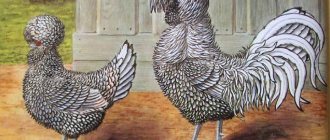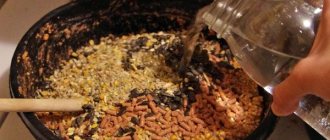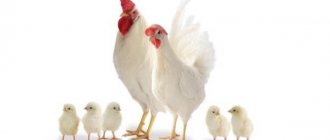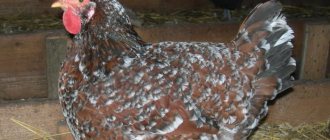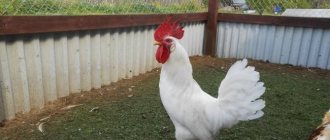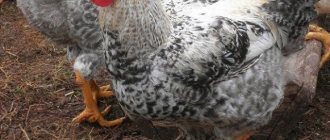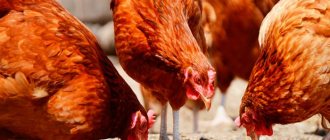Poultry farming » Chickens
0
1030
Article rating
Kira Stoletova
The Tsarskoye Selo breed of chickens, productive and adapted to home conditions, was bred at the VNIIGRZh farm. The new breed was obtained by crossing several breeds - Poltava Clay, Broiler-6, New Hampshire.
Chickens of the Tsarskoye Selo breed
Description
This type of bird has a meat and egg breed, but this breed is also considered an ornamental variety due to its rare color and unique texture. Today, there are no more than three similar types of chickens in the world.
Exterior of a bird
The bird has the following characteristic appearance features:
- Large body, deep and wide set, trapezoidal and slightly elongated.
- The head is small, the neck is long and thin. The beak is yellow-gray.
- The back, chest and belly are wide.
- Legs of medium length, without feathers, interesting yellow-gray hue. The hips are well developed.
- The comb is serrated, pink-shaped or leaf-shaped, bright red.
- The earrings are big.
- The feathers are downed and fluffy, thanks to which the body takes on a more streamlined shape.
- Chickens, unlike roosters, have a lighter color. Red feathers with dark stripes that smoothly turn into white.
- Both hens and roosters have pigtails in their tails that are speckled or black (there are also variations of slight inclusions of gray).
Color
The birds look very colorful and massive, which is explained both by their dense texture and the peculiarities of their plumage. Visually, feathers add additional volume to bird figures. The peculiarity of this breed is its red-striped color. Red shades predominate in the plumage.
Roosters have brighter and more saturated colors. The hens look a little more modest - paler, not too flashy shades. The surface of the feathers is covered with a reddish pattern with characteristic features - light fragments alternate with dark ones. There may also be grayish-black inserts.
External characteristics
Poultry farmers are attracted by the interesting appearance of chickens even more than by their productive qualities. The experimental chickweed also turned out to be attractive. Let's consider several basic characteristics of appearance.
- The first thing to note is the heavy weight and well-developed muscles. Roosters gain about 3.2 kg, and adult laying hens about 2.8 kg. Large-bodied, with a wide back, well-developed hips, belly and chest, the birds also look massive due to their lush plumage. The body structure is typical for representatives of the meat-egg orientation, large, powerful. The body has the shape of a trapezoid.
- Let's look at the features of feather color. Red shades predominate. Traditionally, roosters have a richer plumage color, while hens are slightly paler. The feathers are covered with a striped red pattern, where darker stripes replace light ones. The tail braids may be black. In addition, black and gray inclusions are acceptable.
- The head is small on a long neck. The comb, earrings and earlobes are painted in a rich red hue. The color of the beak is the same as the paws - gray-yellow.
Characteristics
This species of birds has become one of the best options for independent breeding. Their main qualities are discussed below.
Puberty and productivity
Chickens are characterized by high egg production rates. On average, one chicken produces about 165-185 eggs per year. Weather conditions and nutrition have no effect on this indicator, even if the chicken coop is not heated in winter.
Having reached 5 months of age, the hen begins to lay eggs, but it will not be fully formed earlier than by 10 months.
Subject to all the tips for caring for this breed of chicken, an optimal diet, and favorable living conditions, a laying hen can produce more than 200 eggs per year. Starting from the first clutch, the average weight of eggs is approximately 55-72 g. The shell has a beige-brown tint.
Birds fatten very quickly, thanks to which the farmer can save on feed.
Hatching instinct
The birds of the described breed are not whimsical in their living conditions, so incubation makes it possible to achieve almost 100% fertilization of eggs. Excellent brooding properties are exhibited. When working on the Tsarskoye Selo breed of birds, scientists were able to instill this quality in chickens and significantly enhance it.
Females become caring mothers; they do not abandon their nests and offspring, both during incubation and after the chicks hatch, raising them.
Character
There are notes of nobility in the character of this calm poultry:
- chickens are quiet and calm;
- shows favor towards people, there is no aggressive behavior;
- if the family was formed incorrectly, the male is capable of starting a fight with another rooster; this behavior also manifests itself when there is insufficient area for the birds;
- a friendly attitude towards other animals is also manifested;
- birds are bold, active and curious;
- are practically not exposed to stress;
- brave and fearless, birds are ready to protect their family in any danger.
Hatching instinct
Feathered beauties have absolutely no problems in matters of breeding. The testicles are well fertilized and during the incubation process 100% of the offspring can be obtained. But the main advantage is that during the selection process, scientists managed to preserve the ability to incubate.
Tsarskoye Selo chickens, the description of the breed says that they become excellent mothers, do not abandon their nests with eggs, and after the birth of their offspring, they continue to take care of them.
Advantages and disadvantages
Chickens of the described breed have a lot of positive qualities, including:
- high resistance to various diseases;
- rapid growth, rapid weight gain;
- high quality meat;
- undemanding to living conditions;
- can eat a variety of foods;
- birds hardly suffer from obesity;
- about 100% survival rate of chicks;
- high endurance, so even during molting the bird’s body does not weaken;
- can also be grown in the northern regions, since the thick and fluffy plumage reliably protects chickens from frost;
- The character is quiet, calm, flexible and friendly - the birds easily get along with various inhabitants of the yard.
There are also some disadvantages:
- the breed is under development, so there are not yet certain signs that will confirm that the bird belongs to a specific species;
- It is quite difficult to acquire eggs, adult birds and chicks, since the breed remains rare and small in number.
The video below provides an overview of the Tsarskoye Selo chicken breed:
Tsarskoye Selo chickens
Chickens produce offspring that are characterized by:
- good growth rate;
- rapid weight gain;
- high survival rate;
- unpretentiousness to conditions of detention.
Excellent vitality indicators of the younger generation have made this breed very popular among poultry farmers. The survival rate of young animals is approximately 98%; with proper care, 100% can be achieved. The chicks are born very cute - they resemble fluffy yellow lumps.
With proper care, you can achieve 100% survival of offspring
Prices for a ready-made brooder for chickens
Chick brooder
From the first days they begin to grow quickly and become covered with the plumage characteristic of adult individuals. Already at the age of 1.5 months, gender differences are visible. Upon reaching 1 year, they are a fully mature individual with excellent body weight, and can even be sent for slaughter. As a rule, at such a young age, only cockerels are slaughtered. After reaching 12 months, females still serve as brood hens for about 2 years, only after which their performance indicators begin to decline.
Females, after reaching 12 months, still serve as brood hens for about 2 years.
Where to keep chickens of the Tsarskoye Selo breed?
This is an experimental breed that has a lot of positive qualities, but the main advantage is its hardness, endurance and unpretentiousness. These qualities allow even inexperienced farmers to raise birds. Both care and maintenance do not require too large a financial investment or time investment.
Chicken coop requirements
To place the chicken coop, choose the highest possible area, since flooding should not be allowed, which is possible during the onset of spring floods or heavy rains. Only a concrete type of foundation is allowed, because with the help of digging, predators dangerous to birds can get inside the room.
It is advisable that the walls of the chicken coop be wooden. It is required to correctly calculate the internal area of the room, taking into account the following data - per 1 sq. m there can be no more than 10 birds. Be sure to cover the wooden floor with a layer of hay, dried straw or wood sawdust.
The bedding should be changed periodically to help keep the room dry and clean.
Place drinking bowls at such a level that the birds can comfortably reach them. It is best to place them on a slight elevation so that the chickens do not constantly knock them over. Consequently, birds will not wet their feathers and the floor will remain clean longer. You will learn how to make drinking bowls with your own hands from this article.
As for feeders, use ones with small sides. How to make your own chicken feeder is written here.
Place the nests at a height of at least 1 m. Please note that there should be no more than five laying hens per nest. During the winter season, additional lighting is required in the poultry house, which will help extend the incubation time of the eggs. There are no special requirements regarding the insulation of the room, because birds of the described breed can easily tolerate low temperatures.
Walking yard
Like any other poultry, Tsarskoye Selo chickens love and need the opportunity to roam freely. This can be organized in several ways - use an aviary or a walking yard, or release the birds to graze in an open meadow.
To design a walking yard, follow a few simple tips:
- for walks, fence off a dry area, use a fine-mesh metal mesh;
- attach the mesh close to the poultry house;
- make sure that the mesh does not have any damage that could injure birds;
- dig the lower part of the mesh into the ground to a depth of no less than 50 cm;
- Build a canopy over the space where the birds will roam so they can hide from the hot sun or rain.
Nuances of breeding
Acquisition
Breeding Tsarskoye Selo chickens is generally a profitable business. You can provide your family with valuable meat and eggs, or use the products for sale. The process does not require significant time or financial investments.
To begin with, you can purchase a hatching egg or ready-made young animals. The cost of day-old chicks is 150 rubles per piece. Adult birds are sold from 200 to 350 rubles. Hatching egg - 60 rubles.
To purchase chickens of the Tsarskoye Selo breed, you can contact breeding farms. There are several of them: in the Vladimir, Smolensk and Moscow regions.
Hatching instinct
Hens of the Tsarskoye Selo breed have a strong instinct of motherhood. Hens do not leave the nest during the incubation period and take care of the chicks after they hatch. Breeders not only fixed this parameter, but also strengthened it.
Females independently build nests in secluded places. But it is advisable to place them nests in the chicken coop wherever the farmer wants.
Usually 4-5 laying hens occupy 1 nest.
Content
Tsarskoye Selo chickens are not adapted to being kept in cages, so they need to be equipped with a poultry house. It is advisable to choose an insulated room with a good ventilation system. Try to avoid drafts.
Adult chickens
It is not necessary to build perches, since laying hens feel more comfortable if they are on the floor. This will help protect the flock from the risk of accidental falls from high perches, which could result in serious injury. Laying hens are also capable of building a cozy nest for themselves in a remote place.
Females are very energetic, so they need enough space to move around. If the house is crowded, this can lead to periodic fights between laying hens.
Chickens
Chicks should only be kept in warm and well-equipped rooms. But you shouldn’t focus too much on ensuring the correct temperature conditions. Already in the first days after birth, chicks show good resistance to cool air and do not suffer from diseases that are provoked by sudden changes in temperature.
To understand how comfortable the chicks feel, just watch them. When they are cold, they begin to huddle together, trying to find a source of heat. If it’s stuffy, the young become very lethargic, the chickens refuse to eat and sleep almost all the time.
Molting and break in egg production
With the onset of molting, the birds do not suffer or become weakened, which is what makes them different from other species of birds. The duration of molting can be 60 days. If shedding does not begin on its own, you will need to use forced stimulation.
Planned herd replacement
By the age of one year, the birds are almost fully formed and gain good weight. That is why, if necessary, birds can be sent for slaughter. Most often, young males are slaughtered.
Chickens can act as laying hens for 2 years. After this period, there is a rapid decline in productivity indicators.
Puberty and egg production
The productivity indicators of this variety are quite high, so it is kept not only in regions with harsh climates, but also in warm regions. The meat-egg hen begins laying at 5-6 months, but finally matures only at 10-12 months.
The standard assigns an annual productivity figure of up to 170 eggs, but in practice you can get more if you feed the laying hens well and properly care for them.
Farmers also like the fact that Tsarskoye Selo laying hens produce eggs in brown shells. And one more advantage - even at the very beginning of laying, pullets can produce fairly large eggs, and continue to lay eggs in the coldest periods.
Feeding Basics
When creating a menu and feeding schedule for birds, it is worth considering certain factors. The age of the females is of particular importance - for example, young individuals need a diet with a high percentage of protein. After reaching one year of age, it is necessary to gradually reduce the amount of protein consumed by the bird.
Seasonal diet
In order for chickens to produce good offspring and grow quickly, it is necessary to use a three-course feeding system. Do not allow more than 6-7 hours between meals.
Birds should receive at least 80 g of grain per day. Add a wide variety of grains. Sometimes you can give bran to birds. Representatives of this breed can safely consume almost all vegetable crops on their own or in the form of mash.
Greens with fresh tops are excellent sources of minerals, vitamins and other nutrients. Periodically add dry herbs to the food in winter.
Daily ration
It is recommended to include sprouted grains in your daily diet, which is most important in autumn and winter. Complex products containing valuable vitamins are necessary to support bird health and increase productivity during periods of low temperatures.
Minerals are the basis for obtaining eggs with a strong and strong shell, and they also have a positive effect on the bird’s skeleton. Leave feeders filled with chalk or crushed shell rock freely available.
During molting, to maintain the birds' bodies, it is recommended to provide nutritious food and fish oil. The diet has a direct impact on the activity of laying hens - if there is a shortage of feed, the chicken, in order to maintain its own energy potential, temporarily stops laying eggs. But after normalization of nutrition, this process quickly and independently recovers.
Drinking regime plays a big role in the nutrition of birds, so clean water should always be freely available. From time to time you can give yogurt.
An approximate daily ration for one bird might look like this:
- 3-4 types of whole grains (50 g);
- dissolved table salt (0.7 g);
- 3-4 types of grain flour mixture (50 g);
- chalk or crushed shell (5 g);
- wheat bran (10 g);
- pumpkin, cabbage leaves, carrots (40 g);
- meal, cake (5 g);
- pine or hay flour (5 g);
- fish, bone or meat and bone meal (10-14 g).
Sexual maturity, productivity and taste characteristics
Chickens of this breed are classified as meat-egg breeders, but they do not have high productivity rates.
Sexual maturity is characterized as mid-season - chickens begin to lay eggs at 6-8 months.
Egg production is average, per year one hen lays from 160 to 180 eggs weighing 48-53 g with a large yolk (it is 8% more than that of chickens of other breeds). The maximum number of eggs is obtained in the first year of life.
Meat is of high value because it has a delicate structure and many useful substances.
The healing composition of eggs
Eggs are valued for their high taste and healing composition; they are easily digestible.
The composition of green eggs in large quantities includes:
- vitamins A, E, B;
- selenium;
- iodine;
- zinc;
- lecithin;
- amino acids.
Doctors recommend using them for the following diseases and conditions:
- anorexia;
- pica;
- diseases of the cardiovascular system, during recovery after stroke and heart attack;
- disorders of the thyroid gland, diabetes mellitus;
- hormonal imbalances;
- digestive disorders;
- to lower cholesterol;
- to improve immunity;
- for the harmonious development of the child’s body;
- to slow down aging;
- to replenish protein and collagen reserves in athletes.
Dietary supplements are made from egg extract.
Diseases and pests
The successful work of scientists has made it possible to obtain a breed of chickens that is resistant to most diseases. They are not afraid of colds, flu, or viral infections. The greatest danger for chickens is the possibility of infection with parasites, which can occur through contact with rodents or wild birds. They are the most dangerous spreaders of infection.
An excellent prevention of various diseases is timely vaccination of the herd and properly selected, healthy nutrition.
What diseases do they suffer from?
What to watch out for
Breeders managed to develop the Tsarskoye Selo breed of chickens that are resistant to diseases. Birds are not afraid of colds, flu and viruses.
Despite their resistance to diseases, these chickens must be protected from infection by parasites. Severe infections are also dangerous.
Chickens of the Tsarskoye Selo breed become infected with similar diseases from carriers: wild birds, rodents. The reason is also unsanitary conditions.
Signs and treatment
You can find out that a chicken is sick by the following signs:
- lethargy;
- constantly sits in one place;
- closed eyes, reluctance to move;
- apathy gives way to anxiety;
- difficulty breathing;
- makes unusual sounds;
- mucous discharge;
- inflammation near the eyes or cloaca;
- feather loss;
- diarrhea.
The sick chicken is quarantined and treatment prescribed by the veterinarian is started. Vitamin complexes and a lot of greens are added to the food.
The chicken coop and equipment will need to be disinfected.
If the chicken cannot be cured, it is destroyed.
Prevention
Vaccination is used against chicken diseases. Immunity is also supported by a balanced diet.
A necessary measure is rodent control.
Basins with a mixture of sand, dry clay and ash are installed in the chicken coop. Chickens bathe in them to get rid of feather parasites.
When raising Tsarskoye Selo chickens, you need to ensure the chicken coop is warmed up in winter, lowering the temperature as necessary. Otherwise, the cold resistance of chickens may decrease.
Reviews of Tsarskoye Selo chickens
★★★★★
Alla, 25 years old, housewife, Voronezh. A wonderful bird that produces not only eggs, but also delicious meat.
These birds stand out among the general flock due to their large size and body shape. They quickly get used to people and have a calm disposition. They produce large eggs and lay regularly. ★★★★★
Vladislav, 30 years old, dentist, Krasnodar. For the first time I decided to take this breed of chickens to try and decide in the future whether to breed them or not.
I was very pleased that the birds are easy to care for and grow as quickly as broilers. They eat everything, no special nutrition is required. They are not shy, so when I enter the chicken coop, they do not run wild. Hide
Add your review
The Tsarskoye Selo breed of chickens has both advantages and some disadvantages. Thanks to this, they become very attractive and in demand among those who want to breed domestic chickens. Birds have high productive qualities and natural beauty.
0
0
Copy link
Origin and further goals
The primary goal of scientists was to obtain financial benefits. But later poultry farmers admired the unusual appearance of chickens more than other characteristics.
The selection of productive Tsarskoe Selo chickens included:
- Poltava clay breed of chickens;
- red striped broilers;
- broiler-6;
- New Hampshire.
It should be noted: experts are not inclined to call Tsarskoye Selo chickens a breed, since work on their improvement is still ongoing. Breeders think differently.
Breeders plan to create a subspecies suitable not only for household use, but also for breeding on an industrial scale.
Productivity indicators
This is the most important criterion when choosing a breed, so let’s highlight all the points in this direction:
- one female in the first year of her egg production can lay up to 200 eggs, of course, if she is well fed and is in acceptable conditions;
- the eggs are quite large, the weight of one reaches 60 grams, and the color of the shell is yellow-brown;
- females are precocious and can lay eggs after the fifth month of life, and their weight at one year of age reaches 2.5-2.8 kilograms;
- cockerels weigh up to 3.5-3.8 kilograms;
- high survival rate of young animals 95%;
- good immunity, ability to withstand low temperatures.
With all the positive aspects, these chickens also have their disadvantages. The first drawback is the poor mobility of chickens, therefore, they can quickly develop obesity if they are overfed, and this factor, in turn, greatly affects egg production. The second is the rarity of the breed, so young animals are not so easy to buy, and their cost is much higher than that of standard breeds familiar to us.
The standard of chicken beauty
Chickens are the most common and most numerous type of poultry. Over the course of a huge, long history of domestication, a myriad of diverse breeds of this poultry have been bred...
PAVLOVSKI CHICKENS
Pavlovsk chickens are one of the “oldest” breeds of chickens. They are considered the global standard of chicken beauty. Although, until recently, this breed was considered lost...
The main advantage of the Pavlovsk breed of chickens is its unique plumage, which comes in two colors: silver (black and white) and black and gold. And only the tip of the pen is painted black...
CHICKENS SULTANKA
Among egg breeds, meat breeds, meat and egg breeds and ornamental breeds, there are breeds that successfully combine beauty and benefit. First of all, this is a breed called Sultanka
DORKING BREED
Considered one of the best meat breeds. It is the chickens of this breed that have been able to gain enormous popularity among domestic farmers - they have increased endurance and quickly gain the required weight.
ORPINGTON BREED
These are the English aristocrats of the poultry yard
It belongs to the meat and egg type, being very valuable in homestead farming. This is precisely the reason for their considerable price.
In addition, another advantage of Orpington chickens is the variety of colors. At the same time, black chickens are isolated, and this coloring is characterized by the presence of dark skin even on the paws. Feather colors are also popular: gold, birch, hawk, white, porcelain, piebald. There are also pure black, red, blue and striped color options.
PLYMOUTHROCK BREED
They are called American chickens with a European character
Belongs to the meat-egg (universal) type...
Plymouthrock is a large breed of chicken. The birds are distinguished by a rather wide, weighty body, a rather large head with a very strong beak. The real decoration of the breed is its bright red earlobes, oval earrings, and wide convex chest. They are like young ladies; when they walk, they slightly raise their chests - this creates the effect of a proud posture.
BREED FAVEROLE
They are called Baronesses with sideburns
As the name suggests, this breed originated in France.
A distinctive feature of both hens and cockerels is the presence of large sideburns, as well as lush plumage on their paws. These beauties resemble real French baronesses dressed in original carnival costumes
The main color of this breed is “salmon”. Cockerels have white flight feathers and a white back, and the chest, belly and tail are black.
BREED COCHIN
The most amazing, most beautiful breed - it is definitely worth paying attention to. At least for the appearance of the bird
The most famous are Dwarf and Blue Cochin. Although Black, Smoke and White are very common
SUSSEX BREED
One of the oldest breeds on Earth. Belong to meat-egg breeds
Different countries have different standards for the plumage color of this breed, but the most common are: white, Colombian, silver, yellow-Colombian, lavender (lavender), pied and wild brown.
WYANDOTTE BREED
Belongs to the meat-egg type. Its ancestors are Cochin, Brahma and Silver Hamburgbirds.
Although this is a dwarf breed of chicken, they have a fairly large, wide body, deep chest and powerful legs. Distinctive feature: silver-black feather color and pink crest
What to feed the breed?
Birds of this breed should be fed with ready-made feed or mixed cereals. It is advisable to use a composition based on bran, wheat, buckwheat, oats, and corn. It is recommended to add additional vitamins and minerals to this mixture. This will help make your bones stronger.
It is also recommended to give birds coarse salt and ash. They need gravel for better digestion of food. Boiled fish and beans should be used as sources of protein. Meal and sunflower seeds are also added to the mixture.
In summer, representatives of this breed can be free-range. This will help reduce food costs by more than 2 times. Birds eat greens well, which serve as a source of vitamins. It is recommended to harvest dry grass for the winter.
The walking area should contain a lot of greenery - alfalfa, clover. The grass will become a source of nutrition for the birds and will help reduce the amount of dirt in the poultry house.
Chicken nutrition and required diet
The breed is also distinguished by the fact that it is completely unpretentious in nutrition. For good egg production, food must be balanced and nutrition rational. Half of the daily diet consists of grain crops (wheat, oats, corn, rye and barley), and the other half - succulent feed, legumes and fresh greens.
Important. When compiling a diet, it is necessary to take into account the age of the laying hens. Young black whales especially need a protein menu, and only after reaching a year can the amount of protein be reduced.
Half of the daily diet consists of grain crops.
When feeding Tsarskoye Selo chickens, you should adhere to the following rules:
- the daily feed consumption per individual is approximately 120 grams, however, in the summer, chickens are able to obtain food for themselves, which significantly reduces the amount of feed consumed;
- daily feedings should be divided into 3 doses, and the break between them should not be more than 6 hours;
- It is useful to add cake, peas, sunflower seeds, bran, tops and greens to the diet;
- Almost all vegetables are beneficial for chickens - they can be given either separately or as part of mash.
Only chickens may need multivitamin supplements and feed, while adults get by just fine with what the owner provides. However, in winter, you should not neglect vitamins for adult birds - their presence in the body directly affects egg production rates.
Also, to improve productivity, chickens should receive minerals, for example, with chalk, crushed shells or eggshells.
In summer, Tsarskoye Selo chickens actively eat fresh greens.
Thanks to the natural feature of accelerated metabolism, Tsarskoye Selo chickens experience excellent muscle growth even with minimal food consumption.
What do farmers think about the breed?
So, this hybrid is relatively good in terms of productivity. Owners of homestead farms have a very positive opinion about these crosses. Farmers consider the main advantage of chickens of this breed, of course, to be very high egg production rates. In terms of productivity, Highsex are superior to most modern popular breeds.
Another advantage of the hybrid is that it carries for a very long time. Chickens of the Highsex Brown breed have not received as good reviews from farmers in this regard as Whites. The white variety of this bird, even in the third year of keeping, lays eggs almost every day. Browns, unfortunately, lay well only in the first 2 years.
Of course, there are not only positive reviews about these chickens. According to farmers, highsex also has some disadvantages. The disadvantages of chickens of this breed include, for example, poor resistance to cold and a tendency to pecking. Farm owners also consider white crosses to be too shy. The Highsex Brown chicken breed has a more even character. However, representatives of both species often show aggressiveness towards other farm birds.
Teaser network
Many farmers consider a certain disadvantage of these chickens to be the lack of self-preservation instinct. For example, this bird can completely freely try to take food from a dog. Which will most likely end badly for her.
Teaser network
Similar material:
- Pavlovsk chickens: reviews. The best chicken breeds
- The best breeds of laying hens with photos and names
- Meat and egg chicken breed: description of the best breeds
- Liven calico chicken: description of the breed
- Tsarskoye Selo breed of chickens: description, characteristics and reviews
- Phoenix chickens: description, photo
- Leghorn (chicken breed): reviews. High egg production chickens
- Pervomaiskaya chicken breed: description, characteristics, content, reviews, photos
- Australorp chicken breed: description and photo. Meat and egg breed of chickens
- Kotlyarevskaya breed of chickens: description, characteristics, maintenance features and reviews
How to care for a bird
Chickens of the Tsarskoye Selo breed are unpretentious in keeping; there are usually no difficulties with the livestock. Even beginners in poultry farming can cope with the livestock. In summer, birds are kept in aviaries, in winter in a chicken coop. The selectors were concerned about the frost resistance of the individuals, but the temperature in the room must be maintained at 0 C. The walls of the chicken coop are equipped with insulating material. If necessary, install heating equipment.
There are no roosts for chickens. They feel great on the bedding: sawdust and straw are laid on the floor. Floor housing reduces injury to birds. It is necessary to organize nests where hens lay eggs. For 5 hens, 1 nest is equipped. Fresh air and space are important for birds. In small chicken coops and in enclosures with a small area, fights among individuals are possible. Allowed per 1 m2 – 3-4 heads.
Seasonality is taken into account when feeding livestock. Feeding frequency: every 6 hours. Grains per head require 80 g. Cereals are alternated daily. They give oats, wheat, barley, rye. Add corn to the diet. It will increase your caloric intake. To maintain muscle mass, it is necessary to provide a certain amount of not only cereal crops. Chickens are given vegetables and nutritional supplements. What do birds feed in different seasons?
- Summer: grains 75 g, green grass 40 g. It is necessary to introduce bran into the diet. They are rich in protein. The amount of bran is the same at any time of the year - 25 g. The food supplement must contain at least 5 g of animal flour. They give meat, bone or fish meal. It is recommended to alternate between different types of nutritional supplements. Chickens need chalk 6 g, salt 1 g.
- Autumn: amount of grain 60, green grass 40 g. The autumn, winter and spring diet includes boiled potatoes. It is given in 100 g. The food supplement should consist of 2 g of flour, 3 g of chalk, 1 g of salt.
- Winter: grains are given 60 g, green grass is replaced with carrots. It needs 30 g. Be sure to give potatoes, bran, food additive: flour 3 g, chalk 5 g, salt 1 g.
- Spring: grains need 70 g. If there is green grass, then it is given 40 g. Potatoes and bran remain in the diet. Food additive: 7 g flour, 6 g chalk, 1 g salt.
The livestock must be given vitamins and mineral complexes for chickens. It is necessary to follow the desoldering regime. The water is heated to a temperature of 10 C. Nothing is added to the liquid, no disinfectants. Feeders are washed half an hour after feeding. Drinking bowls must be constantly filled. Water is poured in the morning. Before filling, drinkers must be washed with an antiseptic.
In winter, it is recommended to give sprouted grain instead of regular grain. Carrots can be replaced with pumpkin or cabbage. Instead of green grass, grass meal is added to food. Individuals can extract chalk from shell rock. The stone is installed in the room.
Birds of the Tsarskoye Selo breed have good immunity, but the body is most vulnerable during the molting period. At this time, it is necessary to support the immune system with vitamins. Fish oil is introduced into the diet, and the portion of fish meal is increased to 15 g. It is necessary to constantly monitor the behavior and condition of the birds. If laying hens have reduced egg production, then they do not have enough nutrition. During the molting period, the permissible reduction in egg production is 20%.
Selectors have not yet stopped working on the Tsarskoye Selo breed. Hereditary characteristics of egg production and accelerated weight gain are not stable. Experts recommend updating the livestock after 4 years. To do this, purchase eggs or young animals from producers. As an experiment, farmsteaders can try to hatch chickens and organize their own breeding work.
Farmer reviews
Farmers note the good productivity of the breed.
Olga. I originally had 6 hens and 2 roosters. One hen died due to oviduct prolapse. I decided to calculate the average egg production of my hens and it turned out that in 8 months the average Tsarskoye Selo individual produces 164.7 eggs. This is despite the fact that they are kept in an unheated chicken coop, without additional lighting and feed. At the end of August, the hens began molting and stopped producing eggs. From my observations, I would like to note that this breed is more demanding of protein feed than others.
Natalia. I really like Tsarskoye Selo chickens. At 2.5 months the cockerels were already crowing, and at 3 months one was slaughtered for meat. The net weight without paws, offal and head was 1800 grams - for our conditions of detention this is a very good indicator. The bird is very tasty. I kept them in an enclosure and fed them very well. The breed has a fairly good brood - out of 28 eggs, 23 hatch. In addition, they are incredibly beautiful and have unusual, pleasant colors.
